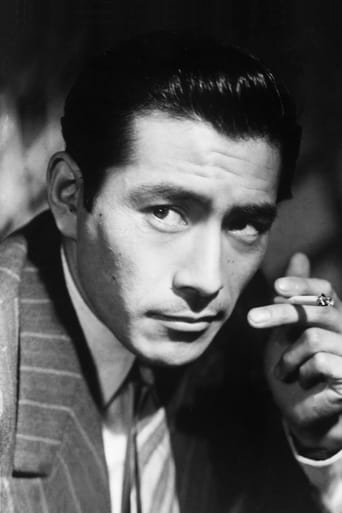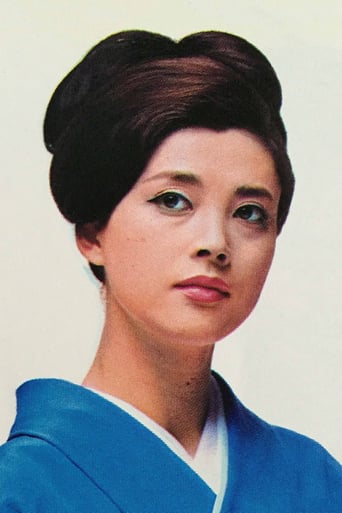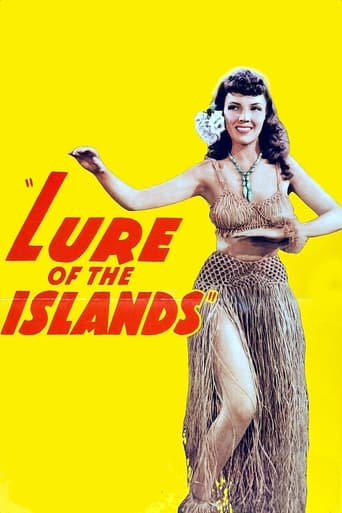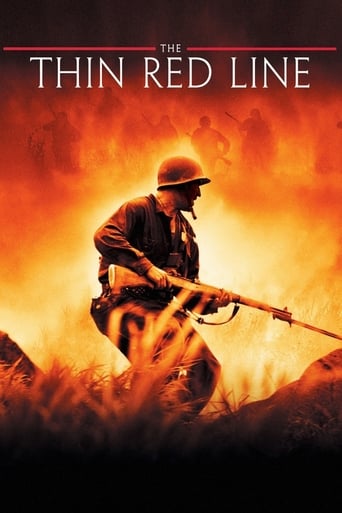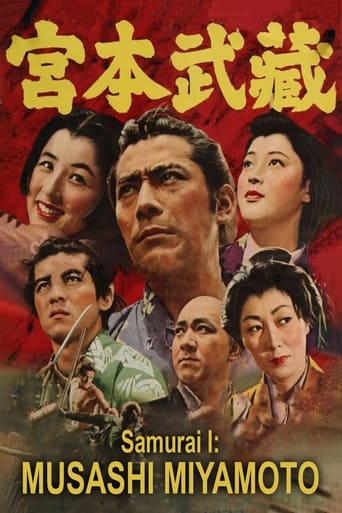

Samurai I: Musashi Miyamoto (1954)
Struggling to elevate himself from his low caste in 17th century Japan, Miyamoto trains to become a mighty samurai warrior.
Watch Trailer
Cast


Similar titles
Reviews
An influential picture of a legendary character. The director precedes Akira Kurosawa and provides the template that is expanded upon by the latter film director. I believe that Kurosawa films are essential for any film lover, but if you fall for well done samurai movies, than this is a must see film. The characters, storytelling and camera techniques are incredibly well done for those who appreciate the historical development of films. This film came out at the same time as Seven Samurai and won the Academy Award for best foreign film. Musashi is a Japanese seventeenth century folk hero who has been depicted in numerous art forms throughout Japanese history.Toshiro takes on the role with complete mastery. It begins with him up on a tree idolizing the marching warriors through his small village. He goes off to war to make a name for himself. His childhood friend decides to follow along despite his engagement to Otsu. In war they encounter defeat and escape to improve. They meet a mother and daughter out in the country who help them heal. Ultimately, Musashi separates from his friend and returns to his town where he becomes a fugitive.As part of a trilogy, this film sets up the stage for the next two, but it also stands very much on its own. Musashi begins as an impetuous young man and the film ends when he has matured. One drawback is that we only get glimpses into the character over long periods of time. Musashi comes off as an intense character, obsessed with fame, even over the company of women. His treatment of women appears to be an honorable characteristic or it could be a reality for someone who has not properly developed certain social skills. There is a certain sympathy that the viewer develops with regard to such a character where fame at all costs stunts the quintessential human drive for companionship and friendship. He becomes a loner that no one can access. The character development from a naive beginning with indiscriminate fighting to a mature more restrained character is engaging. In this film you also have the love triangle that will continue through the subsequent films.The director Inagaki captures incredibly well the local country side scenery full of beautiful mountains. The most memorable scene is when Musashi is hung from a tree by the Zen monk as a way of teaching a lesson. The Zen monk is a memorable character, but I wished that more could have been developed with the Japanese Zen background context. Ultimately, Musashi emerges as a confident man ready to accomplish his goal of becoming a samurai with a better structured agenda. On the side, the viewer is left to contemplate the fates of Otsu, and Musashi's friend Matahachi. A great film that looks into the character side of Musashi whereas the next two installments will make great use of traditional samurai duels.
I've finally gotten down to the first in the trilogy of films based on a story that has been touted as the Japanese's equivalent of Gone with the Wind. The Samurai Trilogy, directed by Hiroshi Inagaki, is based on the novel by Eiji Yoshikawa, which tells of the story of the famous samurai Miyamoto Musashi, and an intriguing character who has authored The Book of Five Rings.What more, the titular character is played by the legendary Toshiro Mifune, and that itself is a major treat and a draw for more contemporary audiences. Sadly to say, as with most first films in a series, this one sets out to establish the baseline character of Mushashi, or Takezo as he's better known in his early days, an orphan brought up by relatives and who possesses great strength, but is brash and ill-disciplined. Together with his best friend Honiden Matahachi (Rentaro Mikuni), who had to leave behind his fiancé Otsu (Kaoru Yachigusa), they sign up for war in the hopes of being samurai warriors at the end of battle, only to discover they're fighting on the losing end, and become fugitives.What transpires later involves their flight from the dark, a couple of seduction scenes by a mother-daughter pair of grave-diggers whose fancies for Takezo gets turned toward Honiden, therein splitting the two best friends up, and Takezo being persecuted by his village folk for deserting his best friend since he returned to the village as the sole survivor. But the shrewd monk Takuan (Kuroemon Onoe) sees a diamond in the rough in Takezo, and therefore sets him up to fall under his tutelage, while at the same time Takezo has to decide for himself how to deal with some new found love in Otsu.There's romance, there's battle scenes, there's the obligatory hero who's still unsure of his destiny. By the time the film ends, it leaves you with a lot of subplots still hanging in the air, but I'm crossing my fingers that all these will be addressed in the next two installments. It's a mid 50s film, so fight scenes aren't that polished to perfection. Instead we see Takezo's rather rough and unfanciful swordplay, in part being the gruff character that he is, knowing no finesse in the art of a duel, and also being a foil for realism, where enemies get cut down ruthlessly without wasting time. Technically one should pass over some of the shortcomings such as abrupt camera angle changes, cuts and edits, and it's indeed a pity that the film is not presented in a widescreen format, which would have been quite a spectacle given the vast landscapes that the film was shot in.Perhaps another indication of how dated this period drama is, is in the treatment of the women characters. I guess given socio-unequalness then, the women folk are seen to be terribly in need of a manly figure to be head of their household, and more than willing to be submissive, and obedient, just so to be at the side of their men. It's a far cry from today's world really, where women are far from the weaker sex they are portrayed in the film. Sure a key female character here is as conniving can be, and future installments (I've taken a look at the cast list) seem to demonstrate that there's still more to it all than meets the eye.In short, Samurai I has set the stage, transforming Takezo from nobody, to a ready warrior yet to be tested in the real world. As he sets out for some reality based education, it would prove all the more interesting as he is likely to chance upon old friends and foes, and this time, being skilled and more refined in his ways, would prove to be engaging material for the subsequent films to deal with. Already those two film titles have "Duels" in them, so they should fill for a climatic finale battle each, given the obvious lack of a crescendo this one turned out to be.
Toshiro Mifune stars as a foolish young man who longs to run off to war to make his fortune and prove he is a man. When a battle looms, he runs off to volunteer and his friend, showing some initial reluctance, follows. Instead of glory, they barely escape with their lives. Their paths leads them to two women--an incredibly evil sociopathic mother and her daughter who is not yet as jaded and selfish as the mother. Mifune resists temptation and runs from them, while his friend succumbs to their pleas to stay--and in essence throws away his life and honor. Where Mifune's path takes him I'll leave for you to discover when you watch the film.Despite having Mifune in the lead, this is NOT an Akira Kurasawa film and some may be disappointed that it is a little more stodgy than one of his films. Instead, I just see it as different but certainly worthwhile. The movie does have tremendous scope and is a very effective opening film to the Samurai Trilogy.It is important to note that these movies were made nearly 50 years ago and existing copies on DVD are in poor condition--with fading and sepia tones instead of the vibrant original. This became VERY apparent when I saw the beginning of the 3rd film. The color was nearly perfect for the initial scene and that is great, as it's a beautiful and extremely artistic shot. At times throughout the movie, some of the scenes are once again vivid while others are faded and lose their impact. You can't blame the film for that, but you wish Criterion would try to digitally enhance the prints they've got to improve the colors and get rid of some scratchy cels.
I have always been fascinated with stories and especially movies that have to do with the Samurai. My first experience was the 47 Ronin. I loved it. I couldn't get enough of it. My second experience was the Seven Samurai. I am going to be bold and admit that I hated it. I don't even like the remakes of it (Magnificent Seven, Battle Beyond the Stars, etc...). At this point I was worried. The Seven Samurai is a highly praised film and story. If I didn't like the "best" would I like less than the "best"? One day I found myself watching a tape of the Shogun's Shadow which is a cheesy samurai action flick. I enjoyed it a little bit but it wasn't what I needed. Low and behold Criterion answered my prayers. I thought maybe if I didn't like Akira Kurosawa's films maybe I would like his competition, Hiroshi Inagaki. Yes, I was correct. Inagaki had to offer what I wanted. The first part of 3 in the tale of Mushashi Miyamoto was everything I had hoped it would be. It was a true rites-of-passage for Takezo (Toshiro Mifune). It chronicled his days as a young idealistic boy to bandit and finally to enlightenment as a Samurai. My only complaint is that I did not buy all three parts of this trilogy. Now I will have to wait until next month to find out what adventures lay ahead for Takezo.


